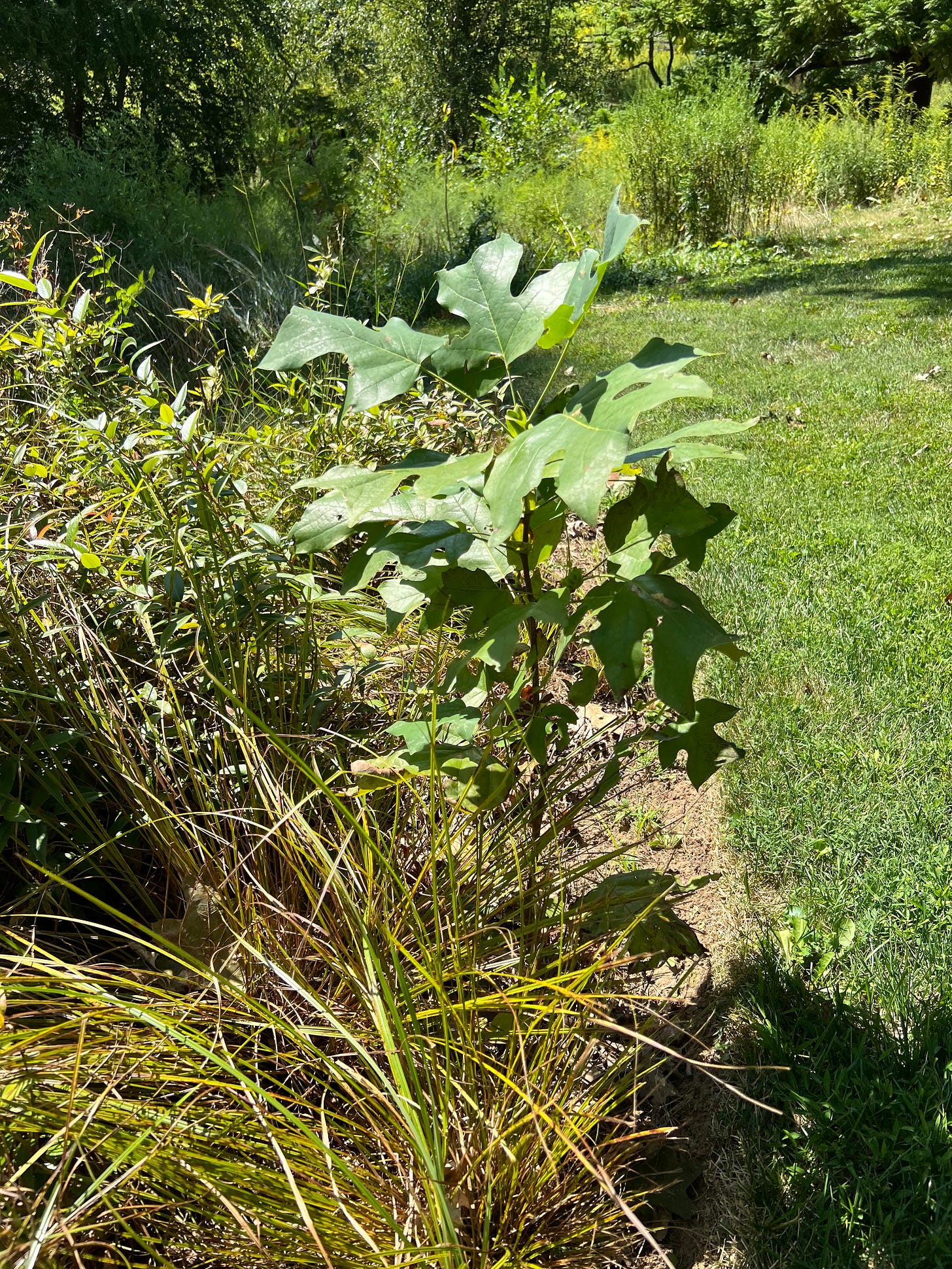Everything’s Coming Up Tulip Trees
Puddock Hill Journal #73: This great native tree punches above its weight.
First, a correction. Last week I identified a plant growing in the walnut woods as native Solomon’s seal . Though a volunteer and not invasive, it is almost certainly an Asian variety. Apologies for the error.
I don’t know exactly what kind of woods the colonists found here when William Penn started divvying up native Lenape land, but I have a hunch that Puddock Hill, if left to its own devices in modern times, would go for a long period with tulip trees among its dominant species.
Tulip trees (Liriodendron tulipifera), also know as tulip poplars or yellow poplars, are members of the magnolia family whose native range stretches up and down the East Coast and well into the Midwest. Under the right conditions, they can seed prolifically and grow remarkably fast.
When we moved to Puddock Hill we had no deer fence around the property, but a chainlink fence surrounded an old garden that had gone to seed. In an old bed grew a tulip tree, probably just a couple years old and already about six feet tall. When we decided to remove the garden and fence, we left the tree. Within ten years, it reached a height of 30 feet, and because it was growing in the lawn as a specimen tree, it had formed a lovely conical shape.
Unfortunately, the old red oak that fell this summer damaged that tree beyond repair, but there are other mature tulip trees about the place—along the driveway, in the east woods, above the big pond, and at the edge of the wet woods—some well beyond a hundred feet tall. In spring a few of their yellow and orange tulip-like flowers get shaken loose and float down to the ground. Seeds, too, though we don’t see those.
No doubt their progeny were attempting to reforest for a decade before we erected the high fence, but voracious white-tailed deer browse left no young tulip trees unmunched. Now that the fence has stood for a few years, however, they’re appearing everywhere. They crop up in garden beds, in areas we occasionally mow, and in areas we never mow. Notably, I recently counted two dozen tulip tree saplings poking through a mass of coral bells (Heuchera spp.) in the small beds on the driveway bridge.
Seeing the whole place as a tree nursery, I’ve transplanted some of this species over the past few years with mixed success. But this year for the first time I have an opportunity to let more than a few grow where they’ve chosen to do so on their own, including many in the east woods, one on the slope above the big pond, and another along the back privacy fence by the walnut woods.
Tulip trees have remarkably large leaves when they’re young, a common adaptation for saplings fighting for light on the forest floor. In my experience, the leaves of mature trees can be just a quarter the size of young ones.
This fall, tulip trees will dominate my sapling relocation scheme, especially in the east woods and outside the fence along the road (with protection). They are a great reforestation tree as they tolerate both full sun and full shade, although of course they grow more slowly in the latter. Four years after we planted a number of whips in the east woods, some of the trees in full sun are 15 feet tall, while those in shade can be less than a third that height.
In addition to their fast growth and light tolerance, I recently learned of another good reason to encourage tulip trees: Their ability to store carbon exceeds that of many other species. In a rather technical paper on tree cell walls that appeared in the journal New Phytologist last July, the authors noted that Liriodendron species emerged coincident with “a rapid reduction in atmospheric CO2 from 1000 ppm down to 500 ppm” during the Silurian period about 450 million years ago. Perhaps not coincidentally, “both species of the Liriodendron genus are exceptionally efficient at” locking in carbon.
As a significant native species, tulip trees also attract birds, butterflies, and hummingbirds, according to the Lady Bird Johnson Wildflower Center, and they serve as larval hosts to the tuliptree silkmoth (Callosamia angulifera) and crowd favorite eastern tiger swallowtail butterfly (Papilio glaucus).
In forests, they grow tall and very straight, which explains why the Lenape used their trunks to make dugout canoes.
We recently freed this tulip tree sapling above the big pond from a sea of invasive Japanese stiltgrass:
Once it goes dormant, this tree will get moved from the planting bed by the house where it took up residence to a woodsier spot:
This volunteer (marked with a stake for protection) just completed its second year by the stream:
In three more years it may look like this one, which began as a whip in the east woods (in nearly full sun):
A shiny sweat bee (Augochlora spp.) explores the last of the mountain mint near the raised bed garden:
Native common boneset (Eupatorium perfoliatum) flowers by the stream:
A sweat bee found the first aster flower of the season, also by the stream:
Nearby, insects cover this patch of goldenrod (Solidago spp.), among the first to fully flower:
Plan for more happy bees and wasps. The path through the barn meadow is going yellow:












I noticed the Soloman's seal thing right away, and I was going to demand a correction. LOLLLLLL :)